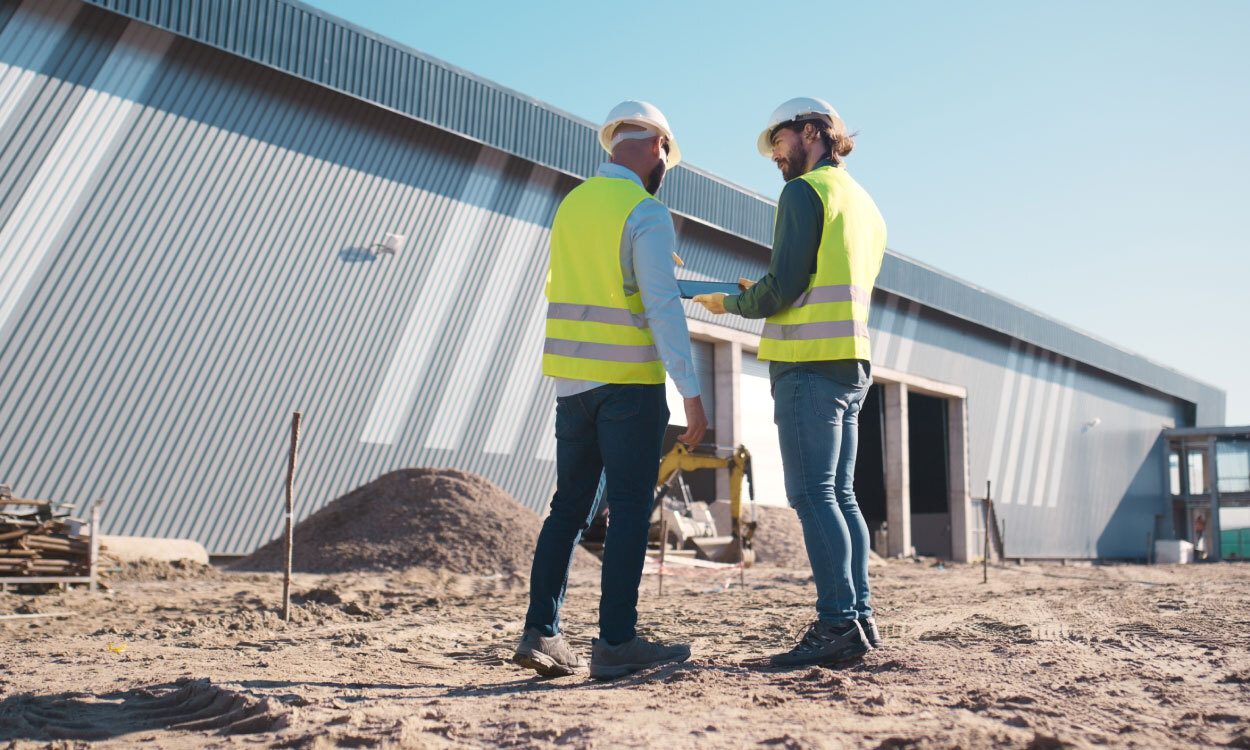

17 Oct 2025
What is a Construction Site Layout Plan?
In construction, making sure everything is properly organised is just as important as the actual execution of the job. From positioning machinery and site offices to making sure workers and materials move around a site safely, every single detail contributes to the efficiency and safety of a construction site.
One essential tool that helps to achieve all of this is a construction site layout plan. It is a map or blueprint that shows all of the temporary and permanent arrangements on a construction site.
For companies operating under the Construction Industry Scheme (CIS), having an effective plan in place not only boosts productivity but also aids compliance as it reduces the risk of an accident happening.
In this article, the team here at Contractwise will break down what a construction site layout plan is and why they are so important.
Read on for more information…
What is a construction site layout plan?
A construction site layout plan is a scaled drawing or diagram that shows the arrangement of all temporary and permanent structures and facilities that are required for a project to be completed successfully. It’s a practical guide that outlines how a site will operate on a day-to-day basis. It includes information regarding people, materials, equipment and more.
A construction site layout plan ensures that all site operations are properly organised to maximise efficiency and health and safety. The best layout plans will also anticipate risks and support compliance with health and safety regulations.
In the context of CIS compliance, a clear site layout can also play a role in demonstrating proper management of subcontractors - reducing the risk of HMRC reclassification.
What should a site layout plan include?
An effective layout plan provides a comprehensive overview of how the construction site is arranged. It will need to be tailored to your specific site, but there are also several key elements that every plan should include:
Cranes and heavy equipment
Cranes are important in most large construction projects. Your site plan should indicate the position, reach and movement zones of each crane to avoid clashing with structures or other machinery. It’s essential to maintain safe exclusion zones and ensure that access roads can handle the delivery of large components.
Site offices
A site office serves as the control centre of any project. It is home to project managers, safety officers and other staff. It should be positioned so that it offers clear visibility of the site and is easily accessible to visitors and staff. Offices also need to have access to utilities like electricity and water.
Off-loading and storage areas
Materials and supplies will likely need to be delivered to your site. The layout plan should show where the off-loading zones are located, with direct routes from site entrances and storage areas for materials that are close to where they will be used, but without causing an obstruction or hazard.
Worker routes and access paths
Clearly defined routes for workers - including pedestrian paths and vehicle lanes - help to reduce congestion and prevent accidents. Routes should be designed to ensure they comply with all the relevant health and safety regulations. This should include safe walkways, signage and lighting.
Access routes and parking
Construction sites require secure and efficient access points for vehicles, deliveries and personnel. The plan should include controlled gates, visitor parking areas and a separate zone for staff and visitors to reduce traffic conflicts. Vehicle loading bays should also be included to make drop-offs smoother.
Electrical installations
All electrical installations, including generators and power distribution boards, need to be clearly mapped out. Proper spacing will prevent overload risks and ensure everything is operating safely.
Temporary facilities
Temporary facilities like canteens, toilets and break areas are essential for the welfare of a workforce. They should be positioned for easy access while also maintaining high hygiene standards.
Waste management
A sustainable site layout will include waste segregation points and recycling areas. Environmental considerations like drainage and dust suppression systems should also appear on your plan.
How to prepare a construction site layout plan
Creating a site layout plan involves both technical and practical decision-making. Here’s a step-by-step process to prepare one most effectively:
Identify what site facilities are needed: Begin by listing all the required facilities - both permanent and temporary. These include offices, storage areas, utilities, welfare facilities, access routes, cranes and security installations. The list will need to reflect the project’s scale, type and other important information.
Determine sizes and constraints: Next, determine the size and shape of each facility. Consider site constraints such as existing structures, the terrain, utilities and any other boundaries. Assessing these factors early will help avoid any costly rework later on.
Establish relationships between facilities: Certain facilities must be located near one another for efficiency. For example, the site office should be near the main entrance, storage areas should be close to construction zones and subcontractor facilities are often adjacent to working areas. Mapping these relationships helps create a functional flow across the whole site.
Optimise the layout: Use the principles of efficiency, safety and accessibility to finalise your layout. For example, place high-traffic areas near main access points and do your best to isolate any hazardous zones. Emergency exits also need to be accessible for everyone.
A construction project’s success depends on much more than just the skill of your staff. It also relies on the organisation and safety of your site. A construction site layout plan brings all of these together and creates a structured foundation for a project to progress efficiently and lawfully.
Final thoughts
At Contractwise, we understand the importance of managing construction effectively. This is why we offer a wide range of services to protect contractors and subcontractors. This includes payroll audits that ensure all staff and subcontractors are recorded properly, avoiding a HMRC reclassification that can have devastating financial consequences. With the help of our expert team, you can focus on your construction project knowing your workforce and compliance needs are handled correctly. For more information, contact our team today.